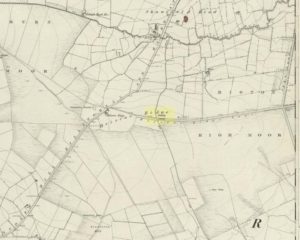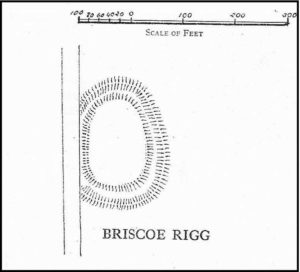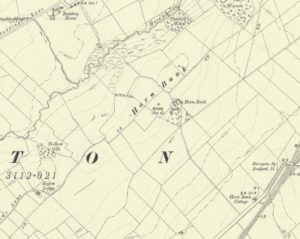Settlement (destroyed): OS Grid Reference — SE 2581 5100
Archaeology & History

Highlighted on the 1851 OS-map of the area as a ‘Camp’, all trace of this ancient settlement would seem to have been destroyed. It was already on its way out when the Ordnance Survey lads looked at it for a second time in 1888, finding barely a trace of it. Thankfully though, when the clearer eyes of that great northern antiquarian Eric Cowling visited the site in the early 1930s, traces of it could still be made out. Both he and fellow antiquarian, Mr B.J.W. Kent of Beckwithshaw, did their own investigations; and it is their notes we are most grateful for in describing this forlorn antiquity. Mr Cowling (1946) wrote:
“On the highest point of the enclosed land on the east side of the Briscoe Rigg (to) Rigton road is a small entrenched site. The enclosed area measures 130 yards from north to south and 70 yards from east to west. The camp is six-sided, but this appears to be due to bad workmanship and layout rather than intention. One gains the impression that the original plan was oblong and that the longer sides were bent to conform to the shorter ones. It is slightly hollow and the whole area is almost levelled by heavy ploughing; the outer bank barely being one foot above the surroundings. The ditch and outer bank now cover a spread of 60 feet.
“Recent hurried investigations by Mr Kent showed interesting details. The area seems to have been occupied by hut-sites previous to the hurried digging of a trench some 16ft wide and 6ft deep, going down into the bed-rock nearly 6 feet. Son after, the ditch was half-filled by boulders and earth amongst which was a fragment of pottery, black in colour and indefinite in type, but probably Roman. When the ditch was half-full it was used for some time for cooking…”

Cowling also told us there was “a tradition that tools, which by description appear to be socketed celts, were found here when the site was brought under cultivation”, in about 1840. Mr Kent also discovered various flints hereby, many Mesolithic scrapers and “a fine Bronze Age barbed and tanged point and also a transverse cutting arrow point of the early four-sided types.”
Although these finds from much earlier periods show that people have been living and hunting in the area for an exceptionally long period, the settlement or camp at Briscoe Rigg was probably built in the early Iron Age period and continued to be used into Romano-British times (somewhere between between 500 BCE and 500 CE).
References:
-
Cowling, E.T., Rombald’s Way, William Walker: Otley 1946.
© Paul Bennett, The Northern Antiquarian
